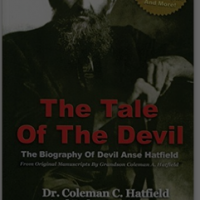Coleman Hatfield’s “Tale of the Devil” is the ultimate “Fact source” for some feud “historians.” I have mostly left “Tale of the Devil” out of my criticism of feud books, because I like the family stories, and don’t consider the book as damaging to historical study as many others.
I think it is now time for me to do a somewhat extensive critique of “TOTD,” so people will have something to refer to when someone trots it out as a fact source.
Coleman Hatfield called his book a “Tale,” and he spins some very interesting tales in the book. But Coleman Hatfield obviously knew very little about the real history of Tug Valley. In fact, he had little knowledge of the real history of his own ancestors.
TOTD says that Johnse Hatfield married Rebecca Browning in 1898, when the marriage actually took place in 1890. Hatfield says that Johnse was convicted in 1898 for the murders of the three McCoys in 1882. In fact, Johnse was convicted in 1899 for the murder of Alifair McCoy in 1888.
TOTD says that Doc Ellis was killed on July 4, but it was on July 3, 1899. That’s a minor error, but there are more.
Hatfield writes that GW Atkinson, as a lawyer, came to Williamson and convinced Elias to surrender. In fact, the trial testimony shows that a doctor named Bartram went to Charleston and arranged with GW Atkinson, who was actually Governor at the time, to come to Mingo County and accept the surrender of Elias. The doctor then convinced Elias to surrender. Governor Atkinson rode a train to Wharncliffe, where he accepted Elias’s surrender in the saloon owned by Elias’s brother, Bob.
Hatfield then spins a ridiculous yarn, saying that Cap broke Elias out of jail and Elias went to the far west for an extended period, after which he returned to WV and stood trial.
In fact, Elias surrendered two weeks after he killed Ellis and went on trial only five weeks later, being sentenced on September 14, 1899. He didn’t have time to even get to the Wild West, much less spend time there. The record shows that Elias spent every day from his arrest through his trial in jail.
TOTD then says that Governor Atkinson pardoned Elias, when it was actually Atkinson’s successor, Governor White.
It is obvious that Coleman Hatfield never laid eyes on the two most important documents pertaining to his own family, the transcripts of the 1899 trials of Johnse and Elias Hatfield. Hatfield either repeated fallacious family legends, or he just made it all up as he went along.
Tale of the Devil is a good tale, but it is not ‘history’ by anyone’s definition of the word. But that did not prevent the book being awarded West Virginia’s “History book of the year” award.
In his general history of the era, Hatfield incorporates the standard feud yarn as ‘history.’ The Hatfield and McCoy feud story, as it exists in popular literature, is a Kentucky story. It originally came to the public from the New York Sun reporter, John Spears. Spears tells his readers who his sources were. They were Randolph, Jim and Sally McCoy, and Perry Cline.
At the time they gave the story to Spears, both Randolph and Jim McCoy were under indictment for the murders of two West Virginians, Jim Vance and Bill Dempsey, as was the son of Perry Cline, John. It should surprise no one that a story coming from Kentuckians who were under indictment for murdering West Virginians would make the Kentucky faction the heroes and the West Virginians the villains.
It is a shame that all the modern West Virginia writers, beginning with Coleman Hatfield, perpetuate this libel of long-dead West Virginians. I have produced the documentary proof, from the courthouses and archives that prove the tale to be a fictionalized slander of West Virginia and its people, but the feud industry persists in propagating the slanders. When will it end.
